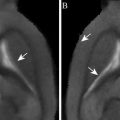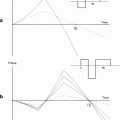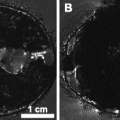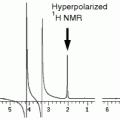Fig. 1.
This flow chart summarizes the various steps a contrast agent is taken through to ensure that it does not deleteriously affect cellular functions, while at the same time to ensure that it causes sufficient signal change to be detected by MRI.
The development of bimodal agents, i.e. probes that can be detected by more than one imaging modality, provide a further development that especially for in vitro studies provides an efficient system to study the incorporation of a contrast agent and its location within the cells (6–8). It is important here to establish that a contrast agent is indeed inside the cells rather than loosely attached to the outer cell membrane as this could lead to the agent being dissociated from the cell and provide false positives upon implantation. It is also noteworthy that some contrast agents will have different relaxation characteristics depending on their cellular location (9). Although these agents provide additional benefits over currently available clinical probes, at present these agents are only used for experimental studies.
The clinical translation of cellular MRI has recently been described with a clinical trial assessing Endorem-labelled dendritic cell placement in patients with lymphomas (10) and the migration of stem cells in a patient with traumatic brain injury (11). Nevertheless, so far, cell tracking has not been robustly implemented in the clinical setting and still requires a further systematic pre-clinical validation to ensure the safety of this procedure. We present here the methodological framework in which the effects of MRI contrast agent incorporation in cells can be assessed prior to progressing to in vivo experiments.
2 Materials
2.1 Laboratory Consumables
1.
24 well plates (Corning, UK)
2.
Anti-LAMP antibody (Abcam, UK)
3.
Anti-dextran antibody (STEMCELL Technologies, USA)
4.
Anti-Ki67 (Novocastra, UK),
5.
FITC-conjugated antibody (Abcam, UK)
6.
Alexa 488 (Molecular Probes, UK)
7.
DAPI in Vectashield (Molecular Probes, UK)
8.
Hoechst (Sigma, UK)
9.
Sigma Fast DAB Tablets (Sigma, UK)
10.
Potassium ferrocyanide stain (Sigma, UK)
11.
DPX (Merck, UK)
2.2 Chemicals
1.
Lipofectamine 2000 (Invitrogen, UK)
2.
Trypan blue assay (Invitrogen, UK)
3.
Fluorescein diacetate assay (Sigma, UK)
4.
CyQUANT assay (Invitrogen, UK)
5.
MTT assay (Sigma, UK)
6.
[14C]-Leucine (1 mL of 1.85 MBq; Amersham International, UK)
7.
(5- and 6)-chloromethyl-2′,7′-dichlorodihydrofluorescein diacetate, acetyl ester (CM-H2DCFDA) solution (Invitrogen, UK)
8.
Triton X-100 (Roche, UK)
9.
Isopropanol (Sigma, UK)
10.
HCl (Sigma, UK)
11.
Nitric acid (Sigma, UK)
12.
Indium (Sigma, UK)
13.
Paraformaldehyde (Sigma, UK)
2.3 MRI Contrast Agents
1.
Endorem/Feridex (Guerbet, France/Berlex, USA)
2.
Gadophrin-2 (Schering, Germany)
3.
Multihance (Bracco, Italy)
4.
Primovist (Schering, Germany)
5.
Resovist (Schering, Germany)
6.
Teslascan (Amersham, USA)
7.
CS-1000 (Celsense, USA)
2.4 Laboratory Hardware
1.
Packard FilterMate (Packard Instruments, UK)
2.
Packard Matrix 9600 β-counter (Packard Instruments, UK)
3.
MRI scanner (Varian, UK) (Note 1)
4.
DTX-880 Multimode detector (Becton Dickinson, UK)
5.
Centrifuge 5804 R (Eppendorf, UK)
6.
Oven incubator (Thermo Scientific, UK)
7.
Inductively coupled mass spectroscopy (Varian, UK)
8.
Hematocytometer (VWR, UK)
3 Methods
3.1 Cell Culturing and Labelling
3.1.1 Cell Culturing
To ensure that cell labelling with an MRI contrast agent is efficient and not affecting cellular functions, it is important to have cells growing in the lab. Most procedures for cell labelling take a few days and it is hence crucial to maintain viable cells during this time. For cell lines or frozen cells that are revived, it is important to proliferate or grow these for at least one passage in the laboratory to ensure that they are healthy and not infected prior to labelling. Once these baseline characteristics are established for cells, it is possible to proceed with the labelling (Note 2).
1.
Grow cells according to the standard protocol as used in the lab.
2.
Ensure that you grow the cells for at least one passage prior to labelling to ensure that they are healthy and not infected.
3.1.2 Labelling
The choice of contrast agent will depend on how many cells and which type of cell one intends to visualize after transplantation. Incorporation of clinically approved contrast agents that can be used for tracking grafted cells are Fe-based agents, Mn-based agents or Gd-based agents (12). Ideally, cellular MRI does not interfere with the general assessment of pathology. The use of alternative nuclei for MR imaging, such as 19F, might therefore be exploited (13).
Pinocytosis. Some cells specifically take up particular contrast agents. For instance, hepatocytes easily take up cell-specific Gd- (e.g. Eovist) or Mn-contrast agents (e.g. Teslascan), whereas Kupffer cells take up Fe-based agents (e.g. Endorem/Feridex). Labelling a particular cell population can therefore be facilitated by choosing the appropriate agent designed to be taken up by this type of cell. Some contrast agents with a small molecular weight, such as Gd-based agents, might also get taken up in vitro into the cells through fluid phase pinocytosis. For this:
1.
Culture cells according to standard protocol
2.
Following overnight incubation of cultures, add the contrast agent at appropriate concentrations to fresh media and gently shake the culture to ensure good mixing of the contrast agent with the media. The concentration of contrast agent will depend on the contrast agent and type of cell. Clinically approved agents generally come in a prepared solution and it is recommended to start with three sets of concentrations 1:1, 1:10, 1:100. A further refinement of this dilution assay is needed to determine the best molar concentration for cell labelling. Knowing the molar concentration will be important to assess the relaxivity characteristics of the contrast agent. Typically, iron oxide-based agents will be in the range of micromolars, whereas Gd-based agents will be in the range of millimolars.
3.
Duration of incubation. Certain cells, such as Kupffer cells, rapidly incorporate contrast agents and incubation times of <2 h can be sufficient for cell labelling. However, duration of incubation also depends on the concentration of contrast agent in the media. The advantage of bimodal fluorescent agents is that during this process, it is possible to assess cellular uptake of the contrast agent dynamically under an inverted fluorescent microscope.
4.
After sufficient contrast agent has been incorporated into the cells, wash the cells three times with PBS before adding media for further experimentation.
Transfection Agents. Although liver cells will easily take up various contrast agents, in some cases it might be desirable, for instance, to label hepatocytes with iron oxide particles that typically are not incorporated into these types of cells. The use of transfection agents can enable this process and ensure sufficient cellular uptake of particles to allow a reliable detection. For this:
1.
Prepare transfection solution with 5 μL of Lipofectamine 2000 in 25 μL culture media for each well on a 24 well plate.
2.
Mix contrast agent with transfection solution for 10 min on a shaker at room temperature. The contrast agent concentration will determine how much agent needs to be mixed with the transfection agent. A typical guidance is about 100 μg of ferumoxides to 5 μL of transfection agent (Note 3).
3.
Incubate for 2–3 h in a 1:1 mixture of serum-free media and transfection agent-coated contrast agents. However, specific incubation times will depend on the contrast agent, the transfection agent and type of cells. These concentrations need to be refined experimentally.
4.
Remove supernatant and wash cells three times with PBS before adding culture media for further experimentation.
3.2 Visualization of Contrast Agent Inside Cells by Microscopy
To ensure that the contrast particles were indeed incorporated into the cells it is necessary to visualize these using microscopy. Although relaxivity measurements (see Section 3.4) can indicate the presence of contrast media, it does not provide an indication if particles are indeed intracellular. Often contrast particles accumulate on the surface of the cells and even after a couple of washes these remain. It is therefore possible that it appears as if contrast agent incorporation occurred, although this is not the case. The only way to ensure that particles are inside the cells, rather than outside, is to perform microscopy. This can be through brightfield (e.g. Perl’s stain to detect iron), fluorescence (anti-dextran antibody to recognize dextran used to chelate many contrast agents) or electron microscopy (EM). Brightfield and fluorescent microscopy are widely available in cell culture laboratory, whereas EM requires highly specialized equipment and access is more difficult. Nevertheless, EM can unequivocally identify metal particles inside the cells and even determine their location.
3.2.1 Detecting Iron Particles
Iron particles can be detected histologically by Perl’s stain (14). For this:
1.
Prepare Perl’s solution with 1.0 g of potassium hexacyanoferrate (ferrocyanide), 25 mL of distilled water and 25 mL of 13% hydrochloric acid. This solution should be freshly prepared.
2.
Wash cells/tissue with distilled water and add Perl’s solution for 20–30 min.
4.
Wash cells/tissue with distilled water and add neutral red to the tissue sections for 1–2 min. For cells, this step can be omitted as neutral red counterstains tissues in shades of red.
5.
Rinse with tap water and dehydrate with graded alcohols (70%, 80%, 100%), clear and mount
6.
Ferric iron will appear blue (Note 4).
3.2.2 Detecting Contrast Agents Based on Dextran
Many MRI contrast agents use dextran as a chelating agent and an immunocytochemical approach can therefore be used to specifically detect dextran-based contrast agent:
1.
Label cells with contrast agent.
2.
Permeabilize cells/tissue with a 0.1% Triton X solution for 5 min.
3.
Rinse cells/tissue with PBS.
4.
Add FITC-conjugated anti-dextran antibody at 1:1000 dilution in PBS to the cells/tissue.
5.
Rinse with PBS.
6.
Counterstain all cell nuclei with DAPI or Hoechst.
7.




The contrast agent will appear in green, whereas cell nuclei in blue.
Stay updated, free articles. Join our Telegram channel

Full access? Get Clinical Tree






